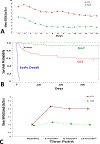Abdominal sepsis patients have a high incidence of chronic critical illness with dismal long-term outcomes
- PMID: 32807383
- PMCID: PMC7731616
- DOI: 10.1016/j.amjsurg.2020.07.016
Abdominal sepsis patients have a high incidence of chronic critical illness with dismal long-term outcomes
Abstract
Background: As hospital sepsis mortality has decreased, more surgical ICU survivors are progressing into chronic critical illness (CCI). This study documents the incidence of CCI and long-term outcomes of patients with abdominal sepsis. We hypothesized that patients developing CCI would have biomarker evidence of immune and metabolic derangement, with a high incidence of poor 1-year outcomes.
Methods: Review of abdominal sepsis patients entered in a prospective longitudinal study of surgical ICU sepsis.
Results: Of the 144 study patients, only 6% died early, 37% developed CCI (defined as ICU days ≥14 with organ dysfunction) and 57% were classified rapid recovery (RAP). Compared to RAP, CCI patients a) were older (66 vs 58), males who were sicker at baseline (Charlson Comorbidity Index 4 vs 2), b) had persistently elevated biomarkers of dysregulated immunity/metabolism (IL-6, IL-8, sPDL-1, GLP1), c) experienced more secondary infections (4.9 vs 2.3) and organ failure (Denver MOF frequency 40 vs 1%), d) were much more likely to have poor dispositions (85 vs 22%) with severe persistent disabilities by Zubrod Score and e) had a notably higher 1-year mortality of 42% (all p < 0.05).
Conclusion: Over 1/3rd surgical ICU patients treated for abdominal sepsis progress into CCI and experience dismal long-term outcomes.
Keywords: Abdominal sepsis; And catabolism syndrome; Chronic critical illness; Immunosuppression; Long-term outcomes; Persistent inflammation.
Copyright © 2020. Published by Elsevier Inc.
Conflict of interest statement
Declaration of competing interest All authors declare no conflicts of interest.
Figures


References
-
- Castellanos-Ortega A, Suberviola B, Garcia-Astudillo LA, et al. Impact of the Surviving Sepsis Campaign protocols on hospital length of stay and mortality in septic shock patients: results of a three-year follow-up quasi-experimental study. Crit Care Med. April 2010;38(4):1036–1043. - PubMed
-
- Dellinger RP, Levy MM, Rhodes A, et al. Surviving sepsis campaign: international guidelines for management of severe sepsis and septic shock: 2012. Crit Care Med. February 2013;41(2):580–637. - PubMed
Publication types
MeSH terms
Substances
Grants and funding
LinkOut - more resources
Full Text Sources
Medical
Research Materials

